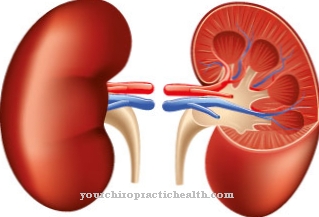Stunted growth in children describe a noticeable growth behavior during adolescence. The so-called growth curve is used as an orientation for classifying a growth disorder.
What are stunted growth?
As Stunted growth in children a growth that deviates significantly from the normal age-related growth process applies. The growth curve is used to determine this. This describes an age-typical ideal growth pattern, but also includes the low and high values that are considered normal.
If the growth pattern of a child lies outside this range, one assumes a growth disorder. The children are then classified as short or tall. Only 0.05 percent of all children are affected by such developmental disorders, the causes of which can be of different nature.
A rough distinction is made here between hormonal, genetically based and disease-related growth disorders. If these causes can be identified as triggers for the developmental disorder and if several studies prove the deviations from the growth curve, one speaks of a growth or developmental disorder in children.
causes
The causes of a Stunted growth in children are of diverse nature. For example, the genetic predisposition and growth of the parents influence the growth curve of their children.
A special case is constitutional short stature. The growth values of the children affected by this are in the lower normal range of the growth curve and the curve of the parents is still normal. However, skeletal development is delayed in these children.
Although puberty is also often delayed, those affected return to normal height in adulthood. The pituitary short stature is considered to be a hormone-related growth disorder and is caused by the fact that the pituitary gland does not produce enough growth hormones. Finally, chronic heart and lung diseases can also cause stunted growth in children, such as so-called secondary short stature.
Symptoms, ailments & signs
In addition to a body size that is too small or too large outside the age-appropriate normal range, various abnormalities can indicate a growth disorder in children. These include an unnatural head circumference that is not age-appropriate and hands and feet that are too small or too large. In many cases, slower tooth development also indicates a growth retardation.
Therefore, the change of teeth also develops later than in children of comparable age. There is also increased fat tissue and a doll-like face. In boys, the genitals are noticeably small. Over a long period of time, the voice remains high and sounding squeaky. The muscle mass is less pronounced and causes less strength. Peers have more energy.
Stunted growth in children often leads to mocking remarks from other children, which can lead to signs of depressive moods. Inferiority complexes and a lack of self-esteem can also present themselves as complaints. A symptom of stunted growth in babies can be significantly low blood sugar levels.
A growth disorder due to a growth hormone deficiency usually affects all parts of the body (proportionately short stature). If an underactive thyroid is responsible for the short stature, the children can suffer from tiredness, dry skin and constipation. A growth hormone deficiency can mean that children often do not want to eat and drink enough. Excessive growth spurts can lead to pain in the limbs, especially during rest periods.
Diagnosis & course
Multiple examinations of the growth progress help to compare your growth pattern with the general age-typical growth curve and Stunted growth found in children. Preliminary examinations before birth can help identify developmental disorders in children.
Further regular growth and weight measurements then result in the child's individual growth curve. Separate rules should be applied to premature babies. If a significant deviation from the normal age-related growth curve is found, a growth disorder in children can be assumed.
Follow-up examinations and the identification of other factors such as diet and digestion, physical activity and symptoms for other diseases, as well as the possible hormonal and disease-related causes of stunted growth in children, help to determine.
Complications
Growth disorders in children can manifest themselves very differently and usually always lead to significantly delayed development. This has a very negative effect on the further life and adulthood of the child concerned. With these disorders, many children also suffer from bullying or depression and as a result sometimes develop mental disorders or even depression.
Significantly reduced self-esteem or inferiority complexes can also occur and make everyday life more difficult for the child. Often the growth disorders in children are also connected with other diseases, so that the children suffer from very fragile bones or from various tumors. This may also limit the patient's life expectancy.
Parents and relatives also very often suffer from depression or psychological complaints. The treatment of growth disorders in children takes place with the help of drugs. In the case of tumors, these must be removed. A completely positive course of the disease does not arise in most cases. With the help of supplements, growth can be accelerated in some cases. An early diagnosis of these disorders always has a positive effect on the course of the disease.
When should you go to the doctor?
If there are abnormalities in children during their natural growth and development process, the observations should be discussed with a doctor. Poor posture, restrictions in movement, pain or other peculiarities indicate a health disorder. A doctor should be consulted so that research into the cause can be initiated. If the child shows significantly reduced or increased growth in direct comparison to playmates of the same age, a visit to the doctor is advisable.
In the case of gait disorders, visual abnormalities in locomotion and unequal lengths of the limbs, medical help should be sought. If problems arise in everyday life or while exercising, the child needs support. Change measures are necessary so that there is no impairment of the quality of life. In the case of stunted growth, you should react as soon as possible. This is essential for the best possible treatment strategy.
The more advanced the disturbances are, the more complex the necessary measures become. In some cases, there is lifelong impairment. If, in addition to the physical abnormalities, there are also emotional stress states, the child also needs sufficient support. In the case of mood swings, behavioral problems and withdrawal from social life, clarification of the triggers and reasons is advisable. In the case of depressive states, outbursts of anger, disorders of eating behavior or irregular sleep, the consultation of a doctor is recommended.
Treatment & Therapy
Genetically determined Stunted growth can be determined in children through preliminary examinations of the fetus and based on the growth pattern of the parents. For example, both hypochondroplasia and vitreous bone disease are growth disorders in children, both of which are due to changes in the same gene. However, these changes manifest themselves in very different disorders of the bone and cartilage structure, of which there are over 200 different variants.
Hormonally caused growth disorders can be treated by the targeted supply of hormones. If a tumor is responsible for the fact that the corresponding gland produces too little or too little growth hormone, the surgical removal of the tumor can have a positive effect on the growth disorder. In any case, precise preliminary examinations are required here.
If children develop growth disorders due to chronic diseases, their therapy can also compensate for the developmental disorder. For example, the consequences of chronic malnutrition can be counteracted through a targeted change in diet or dietary supplements.
Due to the multitude of possible causes as well as the different forms of growth disorders and not least because of the always individual growth pattern of each child, the treatment of growth disorders in children should also be planned individually.
prevention
Stunted growth in children due to malnutrition or malnutrition can be prevented by eating a healthy diet during pregnancy. The child's diet is also crucial here. However, hormonal and genetic growth disorders in children can hardly be prevented, as these factors are not subject to any external influence. Nevertheless, regular examinations by the pediatrician and the determination of the individual growth curve can help to identify growth disorders in children in good time.
Aftercare
Whether follow-up treatment is necessary for stunted growth in children depends on the causes and consequences of the stunted growth and its intensity. If there was only a slight growth disorder that did not result in any secondary diseases, no follow-up treatment is necessary. If, on the other hand, the body's own production of growth hormones is too low, the cause of the growth disorder, regular controls of the growth hormone levels in the blood must also be carried out in adulthood, since adults still produce growth hormones and the body needs them.
If a patient does not produce sufficient growth hormones even in adulthood, these must be supplied artificially by means of drugs. In addition, regular checks of bone density and muscles should be carried out, since growth disorders in children increase the later risk of osteoporosis, malformations of the bones and bone diseases of all kinds as well as muscle diseases.
If a bone disease is found, it must be treated separately. To prevent bone diseases and other consequences of stunted growth, constant intake of calcium and magnesium as dietary supplements in addition to the daily diet can be helpful. This is especially true if a small for gestational age, i.e. a short stature, already existed at birth or a calcium or magnesium deficiency was found in combination with the growth disorder. If nutritional supplements are taken permanently in addition to food, the nutritional values in the blood should also be checked regularly.
You can do that yourself
In the case of growth disorders in children, the focus is on therapy by a doctor. Nevertheless, parents can act in a supportive manner and take measures for self-help.
As a rule, the situation is very stressful for the children concerned and their entire family. Often they even develop inferiority complexes or other psychological problems. Parents should be open and honest about the condition and answer any questions the child may have. The child should have access to all information. Depending on the specific cause of the stunted growth, both the affected children and their families can get help from self-help groups or in internet forums.
Due to the small size of the child, certain problems arise in everyday life, for example when choosing clothing or opening doors. It is important to support the children as much as possible and to make everyday life easier for them. Nevertheless, those affected should by no means be patronized. Parents should assign them certain household chores that they can do despite their limitations. In general, the disease should be taken seriously, but not dominate the everyday life of the family. Regardless of the cause of the stunted growth, the affected children need to eat a healthy and balanced diet.

.jpg)











.jpg)

.jpg)
.jpg)











.jpg)